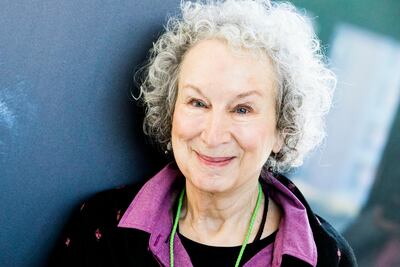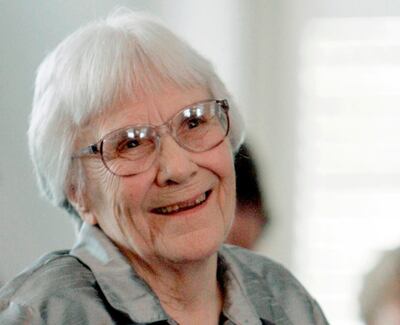The announcement from Margaret Atwood that she is writing a sequel to The Handmaid's Tale – called The Testaments that is due out in September – was greeted with the usual euphoria on Twitter. Among the video clips of celebrities celebrating (Oprah Winfrey, Meryl Streep, Tom Hanks etc) were emoticons of aghast, but overjoyed faces, and vows to bunk off on publication day.
As this general rapture suggests, The Testaments is as close to a sure thing as the literary world gets. In the three decades since its original publication in 1985, The Handmaid's Tale has attained the critical status of a modern classic and won a vast audience in the process: an estimated eight million copies have been printed in English alone.
Not everyone was thrilled, though. The author and critic Charles Finch tweeted: "What a hideous error," adding: "Writers leave your work alone! Henry James showed you what happens!" A few dissenting voices joined the gloom on this thread.
There are solid arguments against Finch's objection. For a start, Finch has so far read only two words of Atwood's sequel and, as titles go, it isn't bad: an allusion perhaps to that most famous two-part story, the Bible, n which the New Testament was a sequel to the Old. Secondly, Finch's reference to James has nothing to do with a habit of writing sequels – which he didn't do – that would be left to later novelists such as John Banville, whose Mrs Osmond continued The Portrait of a Lady. Finch was thinking instead of James' controversial habit of revising existing works, such as serial-turned-novel Roderick Hudson, for the New York Edition.
Finally, Finch's scepticism ignores Atwood's previous good form with sequels. Her 2003 book Oryx and Crake engendered not one but two further instalments: The Year of the Flood (2009) and MaddAdam (2013). Nor were these any old post-apocalyptic sequels. Enacting the unifying theme of gene-splicing, part three simultaneously in the series continued the disparate, but parallel plots of the earlier episodes.
Nevertheless, Finch does have a point. The very love that lays the groundwork for a sequel can also destroy it. As every movie buff knows, for every Empire Strikes Back there is a Jaws II; for every Godfather II, there's a, well, Jaws 3-D.
The arguments for a sequel
Atwood's case is instructive. Success certainly breeds widespread desire for more success. It's doubtful the world would have wanted Bridget Jones: The Edge of Reason if Bridget Jones's Diary hadn't sold by the millions. Willy Wonka wouldn't have ascended in The Great Glass Elevator had Charlie and the Chocolate Factory not been an international hit. Louisa May Alcott's Little Men wouldn't have been born if it wasn't for Little Women two years before.
The number of sales may explain why a sequel happens, but it doesn't justify its execution. The best ones justify their existence through story, most obviously through the continuation of a criminally unfinished narrative. This is why diaries – Adrian Mole's, Bridget Jones's, or EM Delafield's Diary of a Provincial Lady – breed easily and regularly: their inherently linear diary form, which screams 'what happens next?' makes continuation not only desirable, but straightforward.
The appeal of what happens next explains arguably the greatest sequel of them all. Having described how the Greek army arrived at Troy to wage war in The Iliad, Homer told the complex history of their departure in the The Odyssey. James Joyce would ape and deconstruct this one-two punch self-consciously, producing the 20th century's most studied sequel, Ulysses (1922), which continued and expanded his 1916 novel A Portrait of the Artist as a Young Man.
The most famous writer of them all, William Shakespeare, was no stranger to the sequel. There was so much to pack into his historical plays that his dramatic account of Henry IV's reign (1596-1597) required a part two (1597-1598), and even a part three: The Merry Wives of Windsor revisited the light-hearted shenanigans of Falstaff. Henry VI required no fewer than two sequels, written slightly out of order in 1590 and 1591. Sadly, the conclusive end of Hamlet meant that there was no Hamlet 2: Return of the Killer Ghost Hamlet.
Stories vast in scope
The best contemporary narrative-driven sequels have emerged from fantasy, science fiction and that musty hybrid of both, young adult fiction. I exclude crime fiction on the grounds that these days it is more attuned to the serial than the sequel: the continuing arc is determined, not by events, but a central character whose personal and professional soap opera connects disparate cases.
By contrast, J R R Tolkien, J K Rowling, G R R Martin and almost anyone else with an initialised nom de plume created stories so vast in scope and cast that sequels are practically a matter of course. Yet while both Rowling and Martin wrote explicitly with episodes in mind – to track the rapid development of a teenage wizard (Harry Potter) or the fate of an entire continent (Westeros) – Tolkien had sequels thrust upon him.
While such grand storytelling suited his debt to ancient forms – Norse saga, Anglo-Saxon poetry, not to mention Homer, Virgil and other Greco-Roman epics – Tolkien's blockbusting sequels were propelled by market forces initially. The unlikely popularity of The Hobbit in 1936 encouraged Tolkien's publishers to request – and possibly beg – for a follow-up. Proving the truth of the phrase: be careful what you wish for,12 years later Tolkien submitted 10,000 pages that comprised The Lord of the Rings, a sequel so protracted that further division into smaller sub-sequels was inevitable. Tolkien was apparently dismayed: he wanted the whole thing published alongside The Silmarillion.
When disappointment strikes
An even stranger case of enforced sequelisation was experienced by D H Lawrence, who wrote The Rainbow (1915) and Women in Love (1921) as two halves of a whole. Plans to publish both in rapid succession were scuppered by the outrage inspired by The Rainbow, which was banned, in Britain at least, following an obscenity trial on November 13, 1915.
Atwood's truer peers in the case of The Handmaid's Tale are writers who didn't consciously plan to continue a hit book, and only did so some years later. For example, Lewis Carroll (Alice's Adventures in Wonderland and Alice Through the Looking Glass), Joseph Heller (Catch-22 and Closing Time), Salman Rushdie (Haroun and The Sea of Stories and Luka and the Fire of Life).
Here, perhaps, is the sequel's more perilous side. If a story does not obviously or instinctively justify its own extension, and relies perhaps more on commerce, readers' love and nostalgia, the risk of disappointment increases. A combination of age and shifting tastes can rob an author of that old magic. Joseph Heller, like Atwood, took 33 years to follow Catch-22 with the maudlin Closing Time, and many wished he hadn't. It wasn't the weight of expectation that ruined Stephen King's drab Dr Sleep, the sequel to the classic The Shining. King's plodding plot and sententious tone did that just fine.
The story behind Harper Lee's over-hyped Go Set a Watchman was even more complex. Anticipation was generated by the promise of an actual sequel to Lee's one and only To Kill a Mockingbird. Sadly, Go Set a Watchman was not To Kill a Mockingbird 2, as advertised, but To Kill a Mockingbird's first draft.
What made the process less salubrious was Lee's hazy role in agreeing publication. These days, an author's refusal or unwillingness to sequelise is no bar to a follow-up. Jane Austen's Pride and Prejudice has been continued by several writers, most notably Emma Tennant. Margaret Mitchell's Gone with the Wind (1936) begat Alexandra Ripley's fully authorised Scarlett in 1991, and Daniel McCaig's fully authorised Rhett Butler's People (2007).
Finding relevance in today's world
Lengthy gaps between parts do not, of course, necessitate failure. The same shifts that make an author seem out-of-date can also make them seem suddenly topical. So it is with The Handmaid's Tale, which in certain respects has sprouted a sequel already in the acclaimed HBO adaptation, starring Elisabeth Moss as Atwood's pseudonymous heroine Offred, whose narrative has now extended beyond Atwood's original remit. More to the purpose is what Atwood herself called "the world we've been living in". Or, as American satirist Stephen Colbert joked: "Margaret Atwood is writing a sequel to The Handmaid's Tale and Donald Trump is almost finished with the prequel."

Almost every recent assessment of Atwood's original has drawn parallels between her dystopian prophecy of a misogynistic, totalitarian right-wing America and the actual misogynistic, totalitarian, conservative America. Trump, #MeToo, environmental collapse – you name it, The Handmaid's Tale predicted it. Did the book also predict a second part? The Handmaid's Tale ends on a cliff-hanger. "Trust me," says Nick the private eye, without revealing whether such faith is justified or not, "I snatch at it, this offer. It's all that I'm left with." While The Testaments will disprove this last sentence, The Handmaid's Tale teased us with unanswered questions: "Did our narrator reach the outside world safely and build a new life for herself? Our document, though, in its own way eloquent, is on these subjects mute."
Not for much longer. Whether The Testaments will be worth the wait is going to have nothing to do with present excitement and everything with literary power. Readers' reactions will be the sequel that decides Atwood's finished story.


